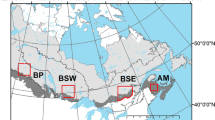Abstract
A methodology for regional application of forest simulation models has been developed as part of an assessment of possible climate change impacts in the Federal state of Brandenburg (Germany). Here we report on the application of a forest gap model to analyse the impacts of climate change on species composition and productivity of natural and managed forests in Brandenburg using a statistical method for the development of climate scenarios. The forest model was linked to a GIS that includes soil and groundwater table maps, as well as gridded climate data with a resolution of 10 × 10 km and simulated a steady-state species composition which was classified into forest types based on the biomass distribution between species. Different climate scenarios were used to assess the sensitivity of species composition to climate change. The simulated forest distribution patterns for current climate were compared with a map of Potential Natural Vegetation (PNV) of Brandenburg.
In order to analyse the possible consequences of climate change on forest management, we used forest inventory data to initialize the model with representative forest stands. Simulation experiments with two different management strategies indicated how forest management could respond to the projected impacts of climate change. The combination of regional analysis of natural forest dynamics under climate change with simulation experiments for managed forests outlines possible trends for the forest resources. The implications of the results are discussed, emphasizing the regional differences in environmental risks and the adaptation potentials of forestry in Brandenburg.
Similar content being viewed by others
References
D. Botkin, Forest Dynamics: An Ecological Model (Oxford University Press, Oxford, 1993).
D.B. Botkin and R.A. Nisbet, Climatic Change 20 (1992) 87–111.
H. Bugmann, On the ecology of mountainous forests in a changing climate: A simulation study, Ph.D. thesis, ETH Zürich (1994).
H.K.M. Bugmann, Ecology 77 (1996) 2055–2074.
G. Bürger, Climate Research 8 (1997) 183–194.
U. Cubasch, K. Hasselmann, H. Hock, E. Maier-Reimer, U. Mikolajewicz, B.D. Santer and R. Sausen, Climate Dynamics 8 (1992) 55–69.
M. Flechsig, SPRINT-S: A parallelization tool for experiments with simulation models, PIK Report 47, Potsdam Institute for Climate Impact Research, Potsdam (1998).
H. Flohn, Das Problem der Klimaänderung in Vergangenheit und Zukunft, Erträge der Forschung, Vol. 220 (1985).
D. Gerold, Modellierung des Wachstums von Waldbeständen auf der Basis der Durchmesserstruktur, Diss. B, Technische Universität Dresden (1990).
F.-W. Gerstengarbe and P.C. Werner, Z. Meteorol. 39 (1989) 224–226.
F.-W. Gerstengarbe and P.C. Werner, Meteorol. Zeitschrift N.F. 1 (1992) 285–289.
G. Glugla, Albrecht-Thaer-Archiv 13 (1969) 371–376.
R. Grote and F. Suckow, Forest Ecology and Management 112 (1998) 101–119.
D. Gyalistras, H. Von Storch, A. Fischlin and M. Beniston, Climate Research 4 (1994) 167–189.
A.J. Hansen, P.G. Risser and F. di Castri, in: Landscape Boundaries, eds. A.J. Hansen and F. di Castri (Springer, New York, 1992) p. 423.
IPCC, Climate Change 1995. Summary for Policymakers (Cambridge University Press, Cambridge, 1995).
R.E. Keane, P. Morgan and S.W. Running, FIRE-BGC — A mechanistic ecological process model for simulating fire succession on coniferous forest landscapes of the northern Rocky Mountains, Research Paper, INT-RP-484, United States Department of Agriculture, Forest Service, Intermountain Research Station, Ogden, UT (1996).
F. Kienast, Landscape Ecology 5 (1991) 225–238.
F. Kienast and N. Kuhn, Vegetation 79 (1989) 7–20.
R. Koitzsch, Z. Meteorol. 27 (1977) 302–306.
H. Kramer, Waldwachstumslehre (Paul Parey, Hamburg, 1988).
N. Kräuchi, Modelling forest succession as influenced by a changing environment, Ph.D. thesis No. 10479, Swiss Federal Institute of Technology, Zürich (1994).
H.-D. Krausch, Potentielle natürliche Vegetation. Ökologische Ressourcenplanung Berlin und Umland — Planungsgrundlagen, UBA Texte, FB 90051 (Umweltbundesamt, Berlin, 1993).
W. Lahmer, D.I. Müller-Wohlfeil, B. Pfützner and A. Becker, GIS-based hydrological modelling with the integrated modelling system ARC/EGMO, in: Int. Conf. on Regionalization in Hydrology, 10–14 March 1997, Braunschweig, Germany (1997) (accepted for IAHS publication).
P. Lasch and M. Lindner, Journal of Biogeography 22 (1995) 485–492.
P. Lasch, F. Suckow, G. Bürger and M. Lindner, in: Past, Present and Future Climate Variability and Extremes: The Impacts on Forests, eds. M. Beniston and J. Innes (Springer, Heidelberg, 1998) p. 273.
R. Leemans and I.C. Prentice, FORSKA, A General Forest Succession Model (Department of Plant Ecology, Uppsala University, 1989).
M. Lindner, Developing adaptive forest management strategies to cope with climatic change, Tree Physiology (in press).
M. Lindner, H. Bugmann, P. Lasch, M. Flechsig and W. Cramer, Agriculture and Forest Meteorology 84 (1997) 123–135.
M. Lindner, P. Lasch and W. Cramer, Climatic Change 34 (1996) 191–199.
M. Lindner, R. Sievanen and H. Pretzsch, Forest Ecology and Management 95 (1997) 183–195.
P. Martin, Australian Journal of Botany 40 (1992) 717–735.
R.P. Neilson, Ecological Applications 3 (1993) 385–395.
C.D. Oliver and B.C. Larson, Forest Stand Dynamics (McGraw-Hill, New York, 1990).
I.C. Prentice, M.T. Sykes and W. Cramer, Ecological Modelling 65 (1993) 51–70.
A.M. Solomon, Oecologia 68 (1986) 567–579.
M. Stock and F. Toth, eds., Mögliche Auswirkungen von Klimaänderungen auf das Land Brandenburg (Potsdam Institute for Climate Impact Research, Potsdam, 1996).
R. Tüxen, Angewandte Pflanzensoziologie 13 (1956) 5–42.
K. Weise and U. Wendling, Archiv für Acker-und Pflanzenbau und Bodenkunde 18 (1974) 145–154.
G. Wenk and D. Gerold, in: Conference on Effects of Environmental Factors on Tree and Stand Growth (Berggießhübel/Dresden, IUFRO S4.0, 1996).
P.C. Werner and F.-W. Gerstengarbe, Climate Research 8 (1997) 171–182.
Author information
Authors and Affiliations
Rights and permissions
About this article
Cite this article
Lasch, P., Lindner, M., Ebert, B. et al. Regional impact analysis of climate change on natural and managed forests in the Federal State of Brandenburg, Germany. Environmental Modeling & Assessment 4, 273–286 (1999). https://doi.org/10.1023/A:1019024619886
Issue Date:
DOI: https://doi.org/10.1023/A:1019024619886




